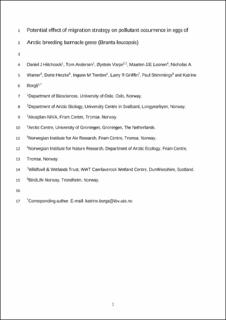| dc.contributor.author | Hitchcock, Daniel James | |
| dc.contributor.author | Andersen, Tom | |
| dc.contributor.author | Varpe, Øystein | |
| dc.contributor.author | Loonen, Maarten | |
| dc.contributor.author | Warner, Nicholas Alexander | |
| dc.contributor.author | Herzke, Dorte | |
| dc.contributor.author | Tombre, Ingunn | |
| dc.contributor.author | Griffin, Larry R. | |
| dc.contributor.author | Shimmings, Paul | |
| dc.contributor.author | Borgå, Katrine | |
| dc.date.accessioned | 2020-08-06T08:13:16Z | |
| dc.date.available | 2020-08-06T08:13:16Z | |
| dc.date.created | 2019-04-04T15:15:06Z | |
| dc.date.issued | 2019 | |
| dc.identifier.citation | Environmental Science and Technology. 2019, 53, 5427-5435. | en_US |
| dc.identifier.issn | 0013-936X | |
| dc.identifier.uri | https://hdl.handle.net/11250/2671025 | |
| dc.description.abstract | Arctic-breeding geese acquire resources for egg production from overwintering and breeding grounds, where pollutant exposure may differ. We investigated the effect of migration strategy on pollutant occurrence of lipophilic polychlorinated biphenyls (PCBs) and protein-associated poly- and perfluoroalkyl substances (PFASs) and mercury (Hg) in eggs of herbivorous barnacle geese (Branta leucopsis) from an island colony on Svalbard. Stable isotopes (δ13C and δ15N) in eggs and vegetation collected along the migration route were similar. Pollutant concentrations in eggs were low, reflecting their terrestrial diet (∑PCB = 1.23 ± 0.80 ng/g ww; ∑PFAS = 1.21 ± 2.97 ng/g ww; Hg = 20.17 ± 7.52 ng/g dw). PCB concentrations in eggs increased with later hatch date, independently of lipid content which also increased over time. Some females may remobilize and transfer more PCBs to their eggs, by delaying migration several weeks, relying on more polluted and stored resources, or being in poor body condition when arriving at the breeding grounds. PFAS and Hg occurrence in eggs did not change throughout the breeding season, suggesting migration has a greater effect on lipophilic pollutants. Pollutant exposure during offspring production in Arctic-breeding migrants may result in different profiles, with effects becoming more apparent with increasing trophic levels. | en_US |
| dc.language.iso | eng | en_US |
| dc.subject | Luftforurensning | en_US |
| dc.subject | Air pollution | en_US |
| dc.title | Potential Effect of Migration Strategy on Pollutant Occurrence in Eggs of Arctic Breeding Barnacle Geese (Branta leucopsis) | en_US |
| dc.type | Peer reviewed | en_US |
| dc.type | Journal article | en_US |
| dc.description.version | acceptedVersion | en_US |
| dc.rights.holder | Copyright © 2019 American Chemical Society | en_US |
| dc.subject.nsi | VDP::Zoologiske og botaniske fag: 480 | en_US |
| dc.subject.nsi | VDP::Zoology and botany: 480 | en_US |
| dc.subject.nsi | VDP::Zoologiske og botaniske fag: 480 | en_US |
| dc.subject.nsi | VDP::Zoology and botany: 480 | en_US |
| dc.source.pagenumber | 5427-5435 | en_US |
| dc.source.volume | 53 | en_US |
| dc.source.journal | Environmental Science and Technology | en_US |
| dc.source.issue | 9 | en_US |
| dc.identifier.doi | 10.1021/acs.est.9b00014 | |
| dc.identifier.cristin | 1690300 | |
| dc.relation.project | Andre: Norwegian Environment Agency | en_US |
| dc.relation.project | Andre: Svalbard Environmental Protection Fund (16/84) | en_US |
| dc.relation.project | Andre: Arctic Field Grant (RiS ID 10386), | en_US |
| dc.relation.project | Framsenteret: Hazardous Substances (WP2.3_2017) | en_US |
| dc.relation.project | Andre: Office of the County Governor in Nordland | en_US |
| dc.relation.project | NILU - Norsk institutt for luftforskning: 117043 | en_US |
| cristin.ispublished | true | |
| cristin.fulltext | original | |
| cristin.fulltext | postprint | |
| cristin.qualitycode | 2 | |
